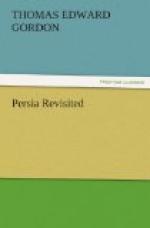The leisure time the servants have is not always well spent, it is true, but they have ideas of imagination and sentiment, which in some degree is suggestive of refinement. I have seen this shown in their love of singing birds, and their dandy ways of dress; for some of them are very particular as to the cut of a coat and the fit of a hat. I have sometimes been interested in seeing them carefully tending their pet nightingales, cleaning the cages, and decking them out with bits of coloured cloth and any flowers in season. In November I saw quite a dozen cages thus brightened, each with its brisk-looking nightingale occupant, put out in the sunshine in the courtyard; and on asking about such a collection of cages, was told rather shyly, as if fearing a smile at their sentimental ways, that there was an afternoon tea that day in the neighbourhood, to which the nightingales and their owners were going. These singing-bird-parties are held in the underground rooms of houses, which are cool in summer and warm in winter, and I imagine the company and rivalry of a number of birds in the semi-darkness, with glimmering light from the ‘kalian’ pipes, and the bubbling of water in the pipe-bowls, and the boiling samovar tea-urns, all combine to cheat the birds pleasantly into believing that it is night-time in the spring song-season.
The Persian poets brought the nightingale much into their songs of praise of earthly joys. The bulbul, of which they wrote and sang, was the European nightingale, which visits Persia in spring to sing and love and nest. They pass as far South as Shiraz, where they meet the plump little Indian bulbul, which is often mistaken for the Shiraz poets’ singing-bird. The word is applied to both species in India and Persia, but the birds are quite different in shape, plumage, and voice. They meet at Shiraz, a place which possesses a climate so temperate and equable as to bring together the birds and fruits of the East and West, North and South; for there I saw and heard the Indian bulbul and the hoopoe, the European nightingale, the cuckoo, and the magpie, and I know that the fruits range from apples to dates.
The nightingale is the favourite pet singing-bird of the Persians. I had good information regarding the manner of obtaining them for cage purposes from some small boys who were engaged picking roses in a rose-garden at Ujjatabod, near Yezd. There are two large rose-gardens in that oasis in the Yezd Desert, where the manufacture of rose-water and the attar essence is carried on. The gardens are appropriately favourite haunts of the nightingales on their return with the season of gladness from their winter resorts in the woods of the Caspian coast. The Persian poets tell of the passionate love of the nightingale for the scented rose, and in fanciful figure of speech make the full-blossomed flower complain of too much kissing from its bird-lover, so that its sweetness goes, and its beauty fades far too sadly soon.




